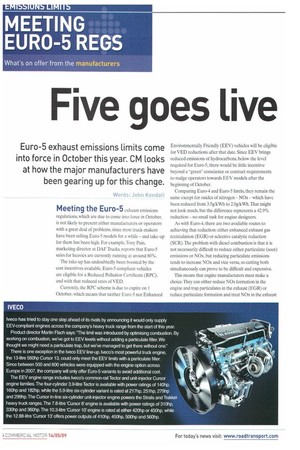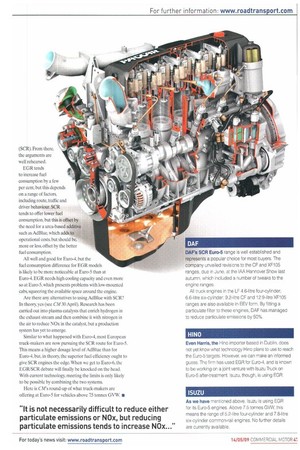Five goes live
Page 46

Page 47

If you've noticed an error in this article please click here to report it so we can fix it.
Euro-5 exhaust emissions limits come into force in October this year. CM looks at how the major manufacturers have been gearing up for this change.
Words: John Kendal!
Meeting the Euro-5 exhaust emissions regulations, which are due to come into force in October, is not likely to present either manufacturers or operators with a great deal of problems, since most truck-makers have been selling Euro-5 models for a while and take-up for them has been high. For example, Tony Pain, marketing director at DAF Trucks, reports that Euro-5 sales for heavies are currently running at around 80%.
The take-up has undoubtedly been boosted by the cost incentives available. Euro-5 compliant vehicles are eligible for a Reduced Pollution Certificate (RFC), and with that reduced rates of VED.
Currently, the RPC scheme is due to expire on 1 October, which means that neither Euro-5 nor Enhanced Environmentally Friendly (EEV) vehicles will be eligible for VED reductions after that date. Since EEV brings reduced emissions of hydrocarbons, below the level required for Euro-5, there would be little incentive beyond a -green" conscience or contract requirements to nudge operators towards EEV models after the beginning of October.
Comparing Euro-4 and Euro-5 limits, they remain the same except for oxides of nitrogen NOx which have been reduced from 3.5g/kWh to 2.0g/kWh.That might not look much, but the difference represents a 42.9% reduction no small task for engine designers.
As with Euro-4, there are two available routes to achieving that reduction: either enhanced exhaust gas recirculation (EGR) or selective catalytic reduction (SCR). The problem with diesel combustion is that it is not necessarily difficult to reduce either particulate (soot) emissions or NOx, but reducing particulate emissions tends to increase NOx and vice versa, so cutting both simultaneously can prove to be difficult and expensive.
This means that engine manufacturers must make a choice. They can either reduce NOx formation in the engine and trap particulates in the exhaust (EGR) or reduce particulate formation and treat NOx in the exhaust (SCR). From there, the arguments are well rehearsed.
EGR tends to increase fuel consumption by a few per cent, but this depends on a range of factors. including route, traffic and driver behaviour. SCR tends to offer lower fuel consumption, but this is offset by the need for a urea-based additive such as AdBlue, which adds to operational costs, but should be, more or less, offset by the better fuel consumption.
All well and good for Euro4, but the
fuel consumption difference for EGR models is likely to be more noticeable at Euro-5 than at Euro-4. EGR needs high cooling capacity and even more so at Euro-5, which presents problems with low-mounted cabs, squeezing the available space around the engine.
Are there any alternatives to using AdBlue with SCR? In theory, yes (see CM 30 April). Research has been carried out into plasma catalysts that enrich hydrogen in the exhaust stream and then combine it with nitrogen in the air to reduce NOx in the catalyst, but a production system has yet to emerge.
Similar to what happened with Euro-4, most European truck-makers are now pursuing the SCR route for Euro-5. This means a higher dosage level of AdBlue than for Euro-4, but, in theory, the superior fuel efficiency ought to give SCR engines the edge. When we get to Euro-6, the EGR/SCR debate will finally be knocked on the head. With current technology, meeting the limits is only likely to be possible by combining the two systems.
Here is CM's round-up of what truck-makers are offering at Euro-5 for vehicles above 7.5 tonnes GVW. •












































































































































